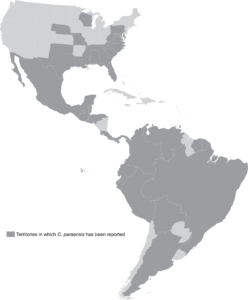
Within 4 to 8 days of being bitten by a mosquito or midge carrying the Oropouche virus (OROV), an acute febrile illness sets in. High fevers (up to 40°C) accompany chills, headaches, joint pains, nausea and photophobia. Some patients can develop rashes reminiscent of rubella, and severe cases may result in neuroinvasive disease such as meningitis. Unfortunately, there are no drugs specific for this infection, so treatment is usually symptomatic and includes pain and fever medication, in addition to fluids. Given the similarity of these signs and symptoms with other acute febrile illnesses, diagnosis can be difficult and may lead to underdetection of cases.
Named after the Oropouche River in Trinidad and Tobago, researchers at the Regional Virus Laboratory identified the virus in 1955. Since then, this tropical infection has stealthily spread across South America and the Caribbean. OROV thrives in a transmission cycle that appears to include three-toed sloths, marsupials and non-human primates, who unwittingly maintain the virus in circulation. Several families of wild birds are also susceptible to infection. It is from all these hosts that the tiny bloodfeeders we all know (and do not love) can take the virus and transmit it to humans.

OROV is an arthropod-borne virus, or arbovirus – it can be transmitted by Culicoides paraensis midges, which are reported as the main vector for this virus. Other vectors include Aedes serratus, Culex quinquefaciatus, Coquillettidia venezuelensis and Mansonia venezuelensis, all of them mosquito species. With an increasing distribution, the once sylvatic cycle now has an urban counterpart where humans seem to be the only hosts, and domestic animals have yet to be found infected (although HI antibodies were detected in chickens). Where have cases happened?
Between January and July of 2024, over 7,700 OROV cases have been reported. This increased dissemination, as with other vector-borne disease, is driven by factors like climate changes, human and animal mobility and behaviour, deforestation and land use.
Since its discovery in 1955, cases have been identified in several countries:
- Brazil: the country has reported around 500,000 cases of OROV infection in the past 48 years. In July 2024, the Pan-American Health Organization (PAHO) published a report with concerns over possible mother-to-child transmission of the virus, with consequences to the foetus still under investigation. PAHO called for countries to be on the look-out for infections during pregnancy, potential birth defects and stillbirths associated with OROV fever.
- Colombia: one of the first reports of local transmission was published in 2017. Several areas of the country have since reported Oropouche fever cases, mainly in the Amazonas region.
- Cuba: in May 2024, Cuba reported outbreaks in the provinces of Santiago de Cuba and Cienfuegos; entomological and epidemiological surveillance were increased.
- Ecuador: the isolation of OROV for the first time in 2020 from a patient in north-western Ecuador led researchers to uncover other febrile illness cases now confirmed as Oropouche fever.
- French Guiana: in 2020, dengue-like cases were reported in the remote village of Saül, with several diagnosed as Oropouche fever; entomological sampling revealed mosquitoes and midges suspected of acting as OROV vectors.
- Panama: an outbreak was reported in 1989 in the Village of Bejuco, 50 km west of Panama City.
- Perú: a first outbreak was reported in 1992 (with gastrointestinal and haemorrhagic clinical manifestations); in 1994, an outbreak of febrile illness was reported in Peruvian troops in Northern Perú. Between 2016 and 2022, six provinces in the country reported OROV fever cases.

There has been some research dedicated to potential vaccines against OROV, but they are still in early stages. PAHO recommendations to date include increased surveillance, prevention, and education; travellers passing through the region should be aware of this (they may be especially vulnerable to infection) and take precautions that include insecticides, repellents and long clothing. There are still many unknowns regarding the epidemiology, diagnosis, clinical outcomes, and transmission cycles. Phenomena such as El Niño and other weather events may affect vector numbers and population vulnerability, increasing the outbreaks we are seeing now – more research is certainly needed to fully understand the Oropouche virus.

Comments